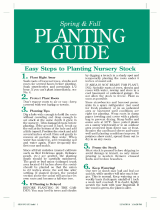Page is loading ...

HOUSEPLANTS
Houseplants purify the air inside your home by filtering out nasty pollutants and toxic chemicals. Ideal for the home or office, these
attractive houseplants will brighten any room. If desired, they may be moved outdoors during the summer months and brought indoors for
winter, or kept indoors indefinitely. They will create a stunning effect no matter where they are planted!
QUICK REFERENCE PLANTING GUIDE
1. Light/Sun Exposure: Bright indirect light.
2. USDA Hardiness Zones: Not winter hardy. We recommend planting in a container so you can move the plant to a
protected area (somewhere that doesn’t freeze) before the first frost.
3. Planting Distance: 3 to 4 feet apart in-ground or 1 plant per 6 inch or larger container. Transplant into larger container as
needed.
4. Mature Height/Spread: 12 to 36 inches tall with similar spread.
5. Bloom Time: Intermittently throughout the year.
6. Container Planting Instructions: Fill the container with soil to within 4 inches of the top. Dig a hole in soil to insert
the lower part of the root ball. Remove plastic containers and loosen up roots that have encircled the growing pot. Place
the plant in the hole and back fill to original soil line. Water well, and if necessary, adjust the plant so that It is upright.
Add additional soil to bring level back up to original soil line. Never insert the plant lower than the original top of the soil
ball.
SOIL PREPARATION
Although these plants will perform in average, well-drained garden soil, for optimum results you may improve your soil conditions as
follows:
1. Spade or till the soil to a depth of 12 to 18 inches.
2. It is always beneficial to add organic matter to your soil. You can mix in a 2 to 4 inch layer of dehydrated manure, garden compost,
shredded leaves, and/or peat moss.
3. After active growth begins, feed with a good water-soluble all purpose fertilizer.
CONTINUING CARE
Watering - Your plants require 1" of rainfall (or equivalent watering) each week when planted in the ground. Do not allow plants in
containers to dry out. In a container that is exposed to full sun, water well at least once every other day, and possibly every day, during
periods of intense summer heat. You may wish to temporarily move the containerized plants to an area where they are shielded from the
hot summer sun (i.e., in the shade of a tree, on a porch near an overhang).
Mulching - Apply a 2 to 4 inch layer of shredded bark, compost, or other organic mulch around your plants to promote moisture
retention, maintain even soil temperatures, and to discourage weed growth.
Weeding - Keep the area around your plants free of weeds. Weeds compete with all plants for food, water, and light. Walk around the
garden periodically and pull weeds, including the roots, as soon as you see them.
Pruning - Clip off dead or unsightly growth as needed to maintain attractive appearance.
Feeding - Discontinue any feeding after September 1st so your plants can harden off for winter dormancy. Resume fertilizing when new
growth appears in spring.
Winterizing - Plants kept outdoors should be protected for winter in order to enjoy them year after year. Do not allow your plant to
freeze. Instead, at the first sign of frost, prune the plant if needed, inspect and treat for pests, then enjoy it as a houseplant during the
colder months.
When you bring your plant indoors for the winter, select a room that is bright, preferably one with a southern exposure. Indoors, plants
tend to dry out from lack of humidity; however, this does not mean to water them daily. Bathrooms, especially those with a southern
exposure, will provide a naturally humid environment for your plants.
If you place your plant in any other room, you can boost the humidity level around your plant by filling a shallow tray with gravel and
water then placing the pot in the tray. The water level should be slightly below the gravel so that the pot is not submerged in the water.
You may also use a spray bottle to mist the plant with water weekly.
Watering should be reduced significantly while your plant is indoors. Do not overwater or allow your plant to sit in water. Follow these
simple steps and remove any unsightly or dead growth over the winter to extend your plant's performance.
In spring when temperatures begin to rise, ease the plant into a full watering schedule and move it back outdoors for the summer if
desired.

/




